Abstract
The present work is devoted to the study of the influence of the parameters of the structural anisotropy of rolled products on the low-temperature impact strength of alloyed steels. A quantitative metallographic analysis of the microstructure of rolled steel samples obtained after testing for low-temperature toughness was carried out. It was established that the main reason for the decrease in the low-temperature impact strength of rolled steel samples is a highly developed segregation band enriched with carbon films formed at the stage of steelmaking conversion in violation of the technology of continuous casting of steel. The microstructural analysis of rolled stock samples was used in the work, and studies of the fracture surface of rolled stock samples were carried out with a scanning electron microscope using X-ray microanalysis methods. The studies carried out showed that the metallurgical quality of sheets of one heat, as well as individual samples within one sheet, varied over a wide range, from satisfactory to unacceptably low. It was established that the main reason for the decreasing low-temperature impact strength of rolled products was a highly developed segregation band enriched with carbon films, formed at the stage of steelmaking in case of violation of the continuous casting of steel technology. The multivariate statistical analysis carried out showed that only the size of the segregation band has an effect on the low-temperature impact strength of 10 mm thick rolled coil samples.
1. Introduction
The constantly increasing demands placed on the quality of rolled products create the need for continuous improvement of its production technology. During the production of rolled products at all technological stages, starting from steel smelting and ending with the thermal processing of finished products, it is necessary to strictly observe the modes and parameters of metal processing established by technological instructions, and adhere to the established standards and rules. The final structure of the finished rolled product is influenced by the parameters and factors that were laid down at the stage of primary shaping of a continuously cast billet in the process of the continuous casting of steel. Thus, the physical and chemical heterogeneity of a continuously cast billet, which takes place at different levels in the height of the ingot, has an unambiguous effect on the structural and chemical heterogeneity of the finished rolled product and the anisotropy of its properties.
Evaluation of the rolled product’s microstructure parameters’ effect on its mechanical properties is one of the most important tasks in determining the compliance of the quality of the finished product with the requirements established by the customer. In case of non-compliance, a decision can be made to transfer the product to a lower quality category or, in general, to recognize it as defective. In this regard, the search for reasons for decreasing mechanical properties of rolled products is the main goal when conducting a technology audit on the conditions of metallurgical production.
It is known that one of the main criteria for the reliability and durability of rolled products is the ability of the material to resist brittle fracture, including that which occurs at low temperatures [,,]. This ability is characterized by such a criterion as low-temperature impact strength, which quantitatively describes the material resistance to brittle fracture [,]. The fracture mechanism is affected by many factors, which include the state of the metal microstructure, non-metallic inclusions, the stressed state of the metal, and the presence of stress concentrators [,,,,,]. In this regard, carrying out multidimensional, in-depth studies of the structural anisotropy parameters’ of rolled products effect on low-temperature impact strength is the main task of this work.
Structural anisotropy parameters of rolled products can include the density, the volume fraction and the nature of the distribution of non-metallic inclusions, the anisotropy of the grain size (structural element) over the width and thickness of the sheet, microstructural banding, the size and the nature of the bainite colonies distribution, and the degree of axial segregation band development [,,].
It is known from the work of present-day researchers that segregation heterogeneity in finished rolled products can be manifested in the form of axial central segregation heterogeneity, which is a consequence of axial chemical heterogeneity, as well as the axial discontinuity of a continuously cast billet []. The degree of the segregation band development in the structure of rolled products depends both on the concentration of highly segregating elements such as sulfur, phosphorus, carbon, non-ferrous metal impurities, a number of alloying elements, and on the crystallization conditions, as well as the solidification parameters of the continuously cast billet [,]. Rolled sheets and coils with a pronounced segregation band are characterized by an increased tendency towards defect formation, including internal delamination with the formation of cracks directed along the interface between the segregation band and the base metal. All this has a negative impact on the finished rolled product’s ductility, and especially on its impact strength [,].
2. Materials and Methods
The authors studied 115 samples of rolled products with a thickness of 10 mm, produced under the conditions of a casting and rolling complex of steel grade 13HFA, of strength category K56, in the form of Charpy samples after impact bending at the temperature of −50 °C. The composition of the steel is given in Table 1.

Table 1.
Chemical composition of the metal under study.
An example of the results of testing samples of rolled products for impact bending is shown in Table 2.

Table 2.
The results of the impact bending test of rolled products.
The samples for metallographic studies were cut from the halves of the Charpy samples cut across relative to the rolling direction after the impact bending test at a temperature of −50 °C To obtain reliable results of metallographic studies, the plane of the section was selected outside the region of plastic deformation of the sample after testing. Figure 1a shows a diagram of cutting out metallographic specimens from Charpy impact specimens after impact bending tests. The dotted line shows the cutting line; the plane of the section was selected outside the area of plastic deformation of the destroyed sample. Figure 1b shows orientation of a rolled product sample for impact bending relative to mutually perpendicular planes and the direction of rolling.
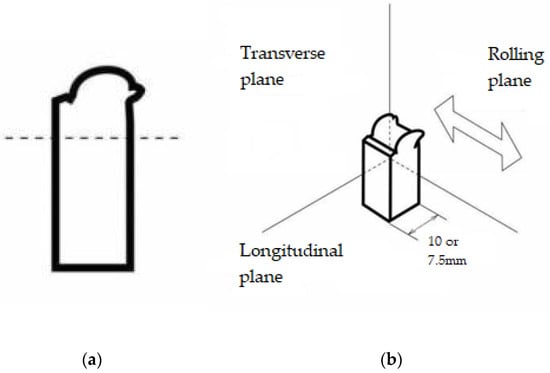
Figure 1.
(a) Scheme of cutting out metallographic samples from specimens after impact bending test; (b) orientation of the sample for impact bending.
Preparation of thin sections was performed with the use of updated equipment for sample preparation by Buehler. Sample cutting was carried out on a Buehler Abrasimet Delta machine (Buehler, Falkenberg, Germany) using an HH type abrasive wheel for metallic materials and steels with a hardness of 50–60 HRC. The samples were pressed in for preparing thin sections in an automatic Buehler SimpliMet 1000 press (Buehler, Falkenberg, Germany). The samples were ground and polished on a Buehler Phoenix 4000 machine (Buehler, Falkenberg, Germany) using the following consumables: Buehler Planarmet, Buehler CarbiMet No. 240 and 600 grinding papers, fabrics, Metadi diamond suspensions, suspension for final polishing MasterPrep []. The samples reveal that the microstructure were etched with a 4% solution of HNO3 in alcohol.
The quantitative analysis of the microstructure was carried out using motorized optical microscopes (Nikon, Tokyo, Japan), Axiovert 200 MAT (Carl Zeiss, Aalen, Germany) and Nikon Epiphot TME ((Nikon, Tokyo, Japan), equipped with an image analyzer. The technique of metallographic studies consisted either of field-by-field analysis of an unetched sample, or in the construction of a panoramic image of the etched structure of the required area at the required magnification and quantitative analysis using the appropriate image analyzer module. The chemical composition of the metal under study was analyzed with a Specromaxx F optical emission spectrometer (Spectro Analytical Instruments, Kleve, Germany).
To establish the quantitative relationship between the parameters of the microstructure and the properties of rolled products, the quantitative analysis of the microstructure of rolled products with the thickness of 10 mm was carried out, using both reference scales and automated methods through the image analysis. Non-metallic inclusions were assessed according to the ASTM E1245-03 standard; the grain size (structural element) was assessed according to the ASTM E1382-97 standard; microstructural banding in accordance with GOST 5640; structural anisotropy and the central segregation region (segregation band) according to scales in accordance with the GB T 13298-2015 standard, as well as morphological and stereological parameters of bainitic colonies [,,].
To evaluate the parameters of the bainite colonies, a special etching agent based on hydrofluoric acid was selected, which made it possible to identify areas with the same crystallographic direction due to the formation of a film of different thickness on their surface. Using special tools of the image analyzer, the maximum length and the average of the three maximum lengths of bainite colonies present on the shelf were measured on the obtained panoramic images. The composition of the etchant solution was: HF 25 mL, H2O 25 mL, glycerol 50 mL. Etching was carried out via dipping, holding for 3 min. The studied surface of the sample during etching should be on top in order to remove the resulting gas bubbles. Gas bubbles can be removed with a cotton swab. As a result of etching, a transparent film is formed on the surface of the sample, which is colored in polarized light, in accordance with the crystallographic orientation of the structural components under it. Panoramic imaging of the sample on the image analyzer was carried out no later than 6 h after etching. However, it is acceptable to study the sample within a week if it is stored in a non-corrosive medium, for example, in a desiccator with silica gel.
3. Results
As the results of metallographic studies show, the microstructure of samples of rolled products of strength category K56 is a ferrite-bainite-pearlite mixture (Figure 2). Etching in the solution of nitric acid revealed a rather strong structural inhomogeneity of the studied samples that was expressed both in the form of large bainite colonies elongated along the rolling direction (Figure 2) of different morphologies and, in some cases, in the form of a developed segregation band (Figure 3).
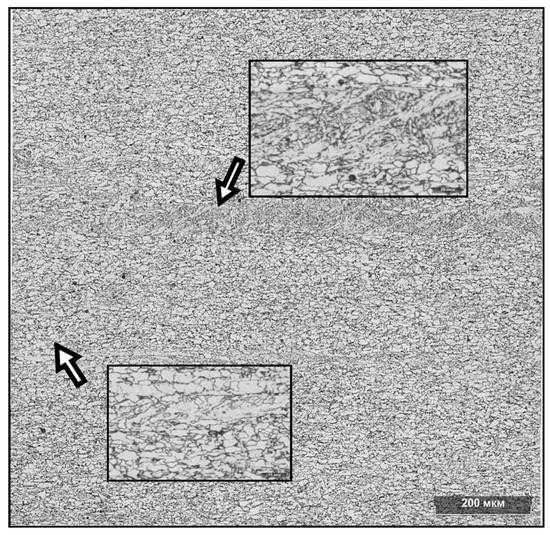
Figure 2.
Panoramic image of the characteristic structure of a coiled product sample.
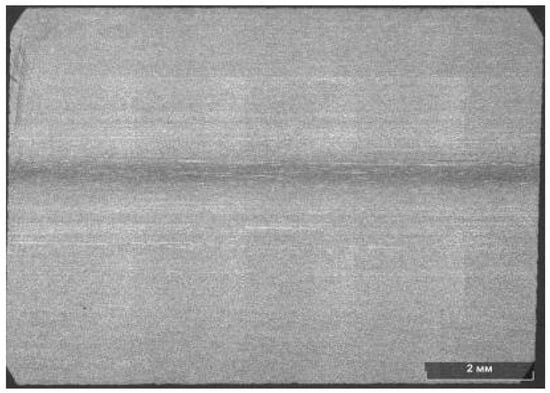
Figure 3.
Panoramic image of a full-thickness rolled product sample with a developed segregation band.
Table 3 shows an example of the results of the evaluation of the grain size number, the structural banding size, the anisotropy coefficient, and the segregation band size for a number of the studied samples of rolled products.

Table 3.
Example of the results of the evaluation of the microstructure parameters of rolled steel samples.
One of the types of bainite that forms extended colonies is bainite with a lath morphology (Figure 4). It is characterized by low-angle boundaries between bainite subgrains, which form bainitic colonies with the same crystallographic orientation. Such areas work as one object and are the most dangerous when destroyed. Bainite colonies with acicular morphology are distinguished by the fact that bainite subgrains have different crystallographic directions with high-angle boundaries that divide the extended bainite region into many structural microelements [].
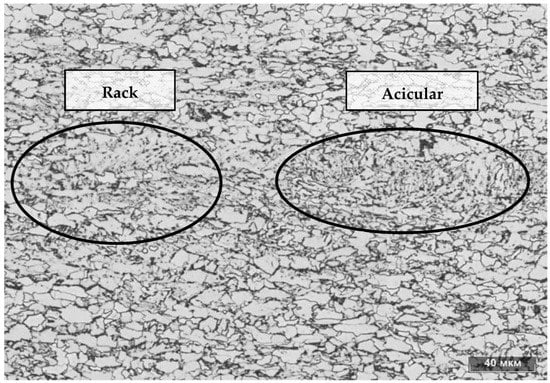
Figure 4.
Two types of bainitic structure morphology in the rolled product sample.
Table 4 shows an example of the results of evaluating the parameters of bainite colonies in rolled steel samples.

Table 4.
Example of the results of the analysis of the parameters of bainite colonies in samples of rolled products.
It is known that the impact strength characteristics depend on the type and distribution of the second (strong) phase. Bainite found in the studied steels is the most complex structure to quantify. Of course, characteristics of bainite can be determined using modern methods based on the use of scanning electron microscopy and backscattered electron diffraction. However, in this work, with the use of special etching methods based on hydrofluoric acid, characteristics of lath-morphology bainite were evaluated via optical methods [,,].
It should be noted that the samples studied in this work did not reveal a pronounced distinctive crystallographic orientation of the bainitic regions. In Figure 5 and Figure 6, the fine-grained structural elements can have different colors, each of which corresponds to one direction. The same can be said about lath-morphology bainite. For these samples, there is no analyzer–polarizer crossover position at which the matrix will have one color in its entirety, and the lath-morphology bainite will have another color. Therefore, the only way to evaluate bainitic colonies in a given structure is to separate them by length.
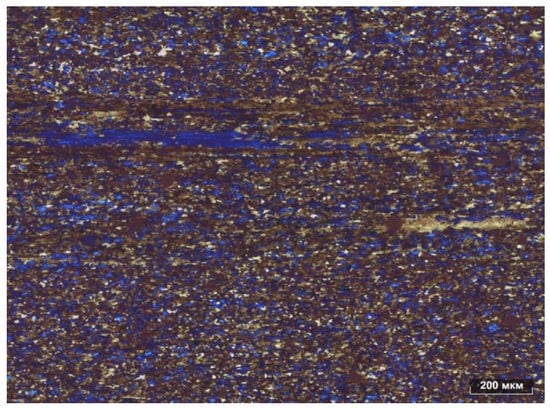
Figure 5.
Panoramic image of the structure in polarized light, ×100.
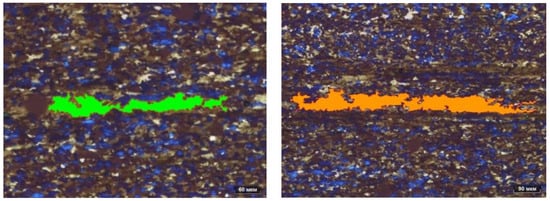
Figure 6.
The structure automatic analysis results.
In this regard, the paper presents the data of the average maximum length of bainite colonies with lath morphology. No quantitative dependence of low-temperature impact strength on the size of bainitic colonies was found (Figure 7). However, it should be noted that the average maximum length of bainitic colonies varies from 170 to 900 microns.

Figure 7.
Coil stock impact strength dependence on the bainite colony size.
The analysis of the obtained results of evaluating metal contamination with non-metallic inclusions showed that the quantitative dependence of low-temperature impact strength on the average volume fraction of non-metallic inclusions, as well as the density of their distribution over the cross-section of the rolled product, was not revealed (Figure 8 and Figure 9). Thus, when the average volume fraction of non-metallic inclusions in the studied samples changed from 0.03 to 0.13%, a clearly pronounced dense “cloud” of clusters of impact strength values from 250 to 350 J/cm2 could be observed, and points with low impact strength values do not depend on the average volume fraction and cannot be explained by the increased content of non-metallic inclusions.
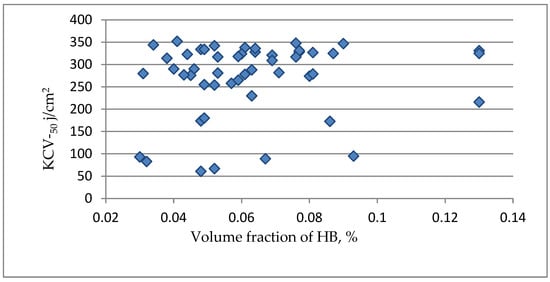
Figure 8.
Impact strength of rolled products’ dependence on the volume fraction of non-metallic inclusions.
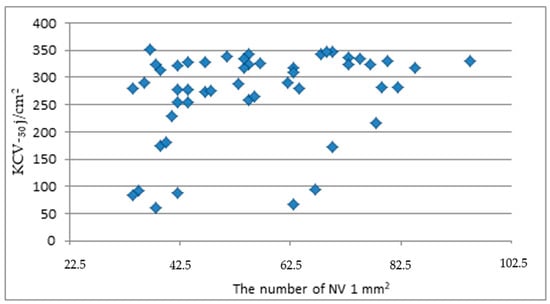
Figure 9.
Impact strength of rolled products dependence on the density of non-metallic inclusions.
Similar conclusions regarding the absence of a quantitative relationship can be drawn from the results of studying the effect of grain size number and microstructural banding on low-temperature impact strength.
For all the studied rolled products, the grain size number (structural element) is in the range of 12–14 (Figure 10). It should be noted that in this work, the number was measured not for a ferrite grain but for a structural element. This approach is used to estimate the grain size number of a mixed structure consisting of crystallites of several phases or structural components, so it is no longer enough to estimate traditionally the grain size number only for polygonal ferrite. If the structure consists of a large number of phases or structural components, as in the case of pipe steels, then the number of boundary systems increases greatly. Therefore, the grain size number of the structure of sheet and coil products intended for manufacturing oil and gas pipelines is actually the size of the structural element that is distinguishable with a metallographic microscope, and a measure of assessing the mixed structure as a whole. Mechanical properties, including impact strength and cold resistance, are determined by the number of boundaries. The greater the number of boundaries, the smaller the size of the structure element.
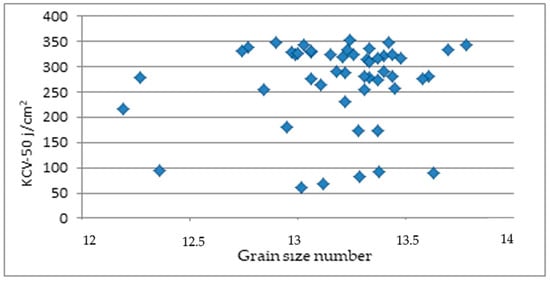
Figure 10.
Coil stock impact strength dependence on the grain size number.
Evaluation of the structural anisotropy of rolled products samples revealed the values of the anisotropy coefficient in the range from 0.65 to 2.4 (Figure 11). To assess the microstructure anisotropy, a special algorithm that estimated the presence and severity of the priority direction of the microstructure was used. One of the ways to identify the textural features of an image is to construct gray level co-occurrence matrices Pd,α, whose elements represent the conditional probability P(i, j) of the occurrence of a pixel with a brightness level i at the distance d in the direction α from a pixel with a brightness level j. Next, a quantitative parameter is calculated that describes the appearance of these matrices: “homogeneity” reflects the grain size number or texture roughness. It is obvious that for images of anisotropic structures, the texture roughness is very different in one of the directions, which means that the sign of homogeneity is also different. The anisotropy coefficient was calculated as follows: several matrices P were built for different directions α, and on the basis of each matrix, the sign of homogeneity H was calculated. The anisotropy coefficient was calculated as the standard deviation of the values H(d, α) calculated for different directions.
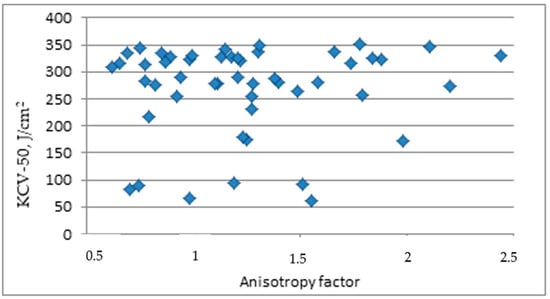
Figure 11.
Rolled product impact strength dependence on the coefficient of structural anisotropy.
The segregation areas found in this work in the central zone of rolled sheets, as a rule, contain coarse traces of zonal segregation, which cannot be eliminated during rolling and which have a negative effect on the mechanical and corrosion properties of steel. For example, it has been experimentally proven that the central segregation zone in sheet metal is prone to sulfide stress corrosion cracking and can cause an overall low corrosion resistance of sheet metal and welded joints []. All the studied samples were analyzed in accordance with the GB/T 13298-2015 method, according to which the segregation band size in the sheet structure was assigned based on studying its central zone at ×200 magnification. In addition, the structure was magnified by a factor of 500 in order to evaluate reliably the non-metallic inclusions decorating the strip. Such inclusions, or a wide single lane, are the basis for assigning an additional penalty of 0.5 points. Size 1 is assigned to a structure with poorly distinguishable intermittent stripes; size 2 is assigned if there are no more than three such stripes; size 3 with more than three bands; size 4 with more than three bands, when they are evenly distributed, close to each other.
Figure 12 shows the results of analyzing the segregation band size in the form of a functional dependence of low-temperature impact strength on the degree of the segregation band development.
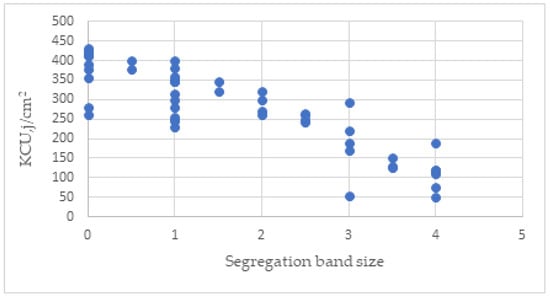
Figure 12.
Impact strength dependence on the segregation band size.
Thus, according to the results of the metallographic analysis, it was found that the only microstructure parameter on which there was a clear dependence of low-temperature impact strength was the segregation band size.
In order to substantiate the limiting values of the segregation band development and to predict the quality and performance of steel as a whole, it is necessary to take into account the formation of heterogeneity at all the stages during dendritic and zonal segregation, as well as during polymorphic transformations in solid steel. Thus, it is necessary to evaluate all the mechanisms of chemical and related structural heterogeneity formation along the through technological process: from smelting and casting to obtaining finished sheet products.
It is known that the degree of zonal segregation is determined by a combination of several factors, which include the composition of the steel and its metallurgical history [,,]. Metallurgical heredity in the cast state is characterized by dendritic and zonal segregation, which is manifested during the crystallization and solidification of steel, due to various thermo-physical and hydrodynamic conditions for the formation of certain structural zones of the slab.
Dendritic segregation, the features of which are adequately described by the Gulliver–Scheil equation, determines the depth of the zonal segregation development. During crystallization, the size of dendrites in a slab can reach several centimeters, but the lower the dispersion of the dendritic structure, the smaller the subsequent inhomogeneity over the cross section of the billet.
Structural heterogeneity was observed in the axial zone of sheet metal is primarily associated with metallurgical heredity. Inhomogeneity formed during zonal, dendritic, and intragranular segregation of carbon and other alloying and impurity elements was also observed after heating for rolling. The processes occurring during thermo-mechanical treatment have a significant effect on the distribution of elements during polymorphic transformations [,]. This is due to the fact that during precipitation of ferrite at the final stage of rolling in the temperature range of the two-phase region, a fairly complete redistribution of these elements occurs during austenite decomposition. Disintegration of austenite occurs due to the nucleation of ferrite grains at its boundaries. Further growth of ferrite is accompanied by the displacement of strongly segregating elements deep into the body of austenite grains due to the increased solubility of these elements in austenite.
To determine the reasons for the effect of the degree of the segregation band development on low-temperature impact strength, the analyses were carried out on the fracture surface of samples of rolled products using a scanning electron microscope, using X-ray microanalysis methods. The X-ray microanalysis was used to determine the composition of various phases in the structure: inclusions, raids, foreign bodies. Examples of images of fracture surfaces obtained on a scanning electron microscope with various types of fractures are shown in Figure 13.
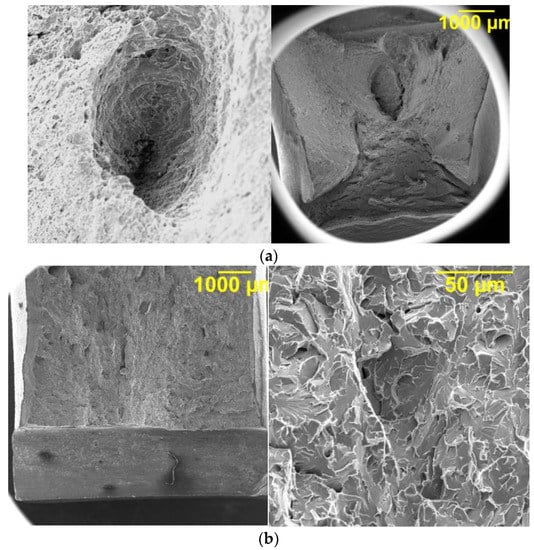
Figure 13.
Fracture surfaces of rolled product samples with different character of fracture: (a) ductile sample; (b) sample with clear brittle fracture by means of break away (transcrystalline cleavage).
It has been established that in the case of fracture by transcrystalline cleavage, the fracture path corresponds to a certain intragranular plane, which is a certain crystallographic plane. In most BCCs of metals, this fracture plane belongs to the {100} family. It is obvious that the destruction plane changes its orientation from grain to grain. As a result, the average grain size can be measured on the fractogram. At a higher magnification, many details typical of a cleavage can be identified: the appearance of a stream pattern, tongues on the cleavage facets, centers of cleavage cracks, wide open secondary cracks.
In the fractographic analysis of the fracture surfaces of samples with impact strength values lower than 100 J/cm2, dark dotted areas were revealed (Figure 14). A certain elemental composition in these areas permits the conclusion that the destruction surface is covered with oxide (Al, Si, Ca oxides) and carbon films. A more detailed study of fracture surfaces at a magnification exceeding 5000 times made it possible to detect the thinnest films covering the surface and repeating its relief (Figure 15). This is evidence of the presence of carbon and oxide films in defective samples, which are a metallurgical defect and cause a drop in low-temperature impact strength.
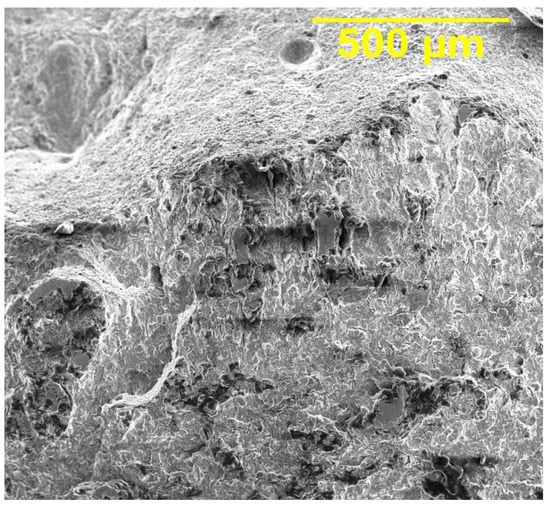
Figure 14.
The fracture surface of a rolled product sample image.

Figure 15.
A film on the surface of a transcrystalline cleavage.
Based on the results of X-ray microanalysis destruction surface, it can be argued that the composition of the film includes Al, Si, C, Na, K. The reason for their formation may be slag-forming mixtures (SFM) used in continuous casting steel, which include these elements [,,].
In case of violation of the technology of supplying the SFM to the metal mirror in the mold, as well as its composition and quality, the liquid metal can interact with carbon of the slag-forming mixture. The bubbles of carbon monoxide formed by the reaction 2C + {O2}→2{CO} remain in the structure of the finished workpiece. When the metal is cooled to the temperature of about 800 °C, the reaction 2{CO}→C + {CO2} actively proceeds (Figure 16) with carbon emission to the surface of the microcavities.
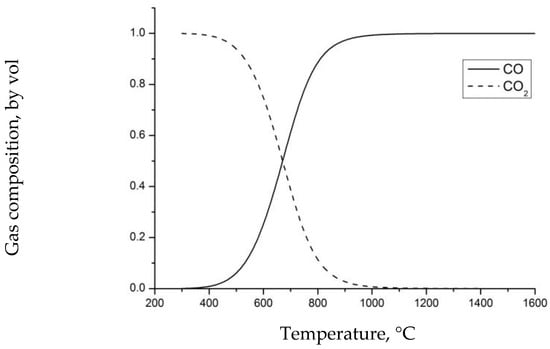
Figure 16.
Equilibrium gas composition for the reaction 2{CO} = C + {CO2}.
Released carbon dioxide is an oxidizing agent with respect to the metal matrix. According to the reactions, Fe + {CO2}→FeO + {CO}, 3Fe + 4{CO2}→Fe3O4 + 4{CO}, there are formed iron oxides FeO, Fe3O4. The final equilibrium ratio of the iron-carbon-oxygen system phases, taking into account all the reactions, is shown in Figure 17. In addition to oxidizing iron, carbon dioxide will also be an oxidizing agent for aluminum, silicon, and manganese, which are part of steel and have an increased affinity for oxygen.
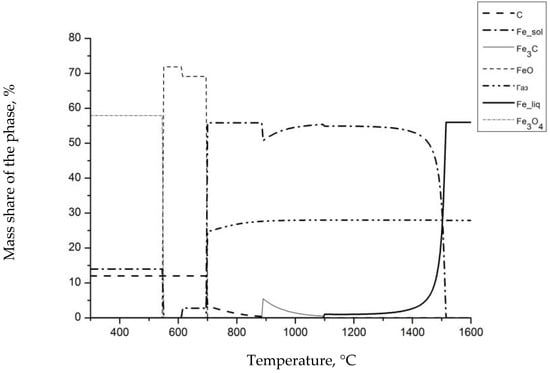
Figure 17.
Equilibrium phase ratio in the system under study.
To establish the regularities of the microstructure parameters’ effect on low-temperature impact strength, the multidimensional regression statistical analysis of experimental data was carried out in the work. The purpose of the analysis was to evaluate the effect on impact strength of the following microstructural parameters: the volume fraction of non-metallic inclusions (VHB, %), the average diameter of non-metallic inclusions (DHB, μm), the density of non-metallic inclusions (PHB, 1/mm2), the microstructural banding size, the coefficient structural anisotropy, the grain size, the maximum size of lath morphology bainite blocks Dmax (bainite), μm), the segregation band size.
It has been established that for all the parameters, except for the segregation band size, the significance level is more than 0.05, which means that it is impossible to reject the hypothesis of the zero value of the regression equation coefficients for these parameters. Thus, only the segregation band size has an unambiguous effect on the low-temperature impact strength.
The highest coefficient of determination was obtained using the quadratic dependence of impact strength on the size of the segregation band. The resulting regression equation has the following form (where L is the segregation band size):
KCV−50 = 322.12 − 9.53 ∗ L2, R2 = 0.86.
The value of the coefficient of determination shows that the dependence is quite clear.
4. Conclusions
The results of this study have shown that the technological process implemented in the casting and rolling complex does not provide the same sheet quality, not only from heat to heat but also on individual sheets of each heat. The metallurgical quality of sheets of one heat, as well as individual samples within one sheet, varies over a wide range from satisfactory to unacceptably low.
It was established that the main reason for a decreasing low-temperature impact strength in rolled products is a highly developed segregation band enriched with oxide and carbon films formed at the stage of the steelmaking process, when the technology of continuous casting of steel is violated.
The multivariate statistical analysis carried out showed that only the segregation band size affects the low-temperature impact strength of 10 mm thick rolled products. The highest coefficient of determination was obtained using the quadratic dependence of impact strength on the size of the segregation band. The resulting regression equation looks like this: KCV = 322.12 − 9.53 * L2, R2 = 0.86.
The expanded database collected using the methods used in this work can serve as a basis for the interpretation and improvement of the end-to-end technology of its production—from out-of-furnace processing, casting, and crystallization, to the winding of finished rolled products into rolls.
Author Contributions
P.K., T.K. and A.I. conceived and designed the concept of the research and methodology. S.K. and V.K. performed material investigations and contributed to paper’s editing. S.A. performed metallographic studies, further data analysis, and interpretation. T.K., P.K. and V.K. supervised and substantively revised all works and the article text. All authors participated in writing the paper. All authors have read and agreed to the published version of the manuscript.
Funding
This research was funded by the Science Committee of the Ministry of Science and Higher Education of the Republic of Kazakhstan (Grant No. AP15473207): “Development of technology for the manufacture of defect-free homogeneous castings by casting on gasified models”.
Conflicts of Interest
The authors declare no conflict of interest.
References
- Efron, L.I.; Volkova, E.A.; Kudashov, D.V.; Ringinen, D.A.; Bagmet, O.A.; Smetanin, K.S. Formation of structure and properties of low-carbon pipe steel with superlow manganese content during thermomechanical treatment. Metallurgist 2021, 3, 34–47. [Google Scholar] [CrossRef]
- Kudrya, A.V. The role of multi-scale structures in providing plasticity and toughness of structurally inhomogeneous steels. Met. Sci. Therm. Process. Met. 2005, 5, 18–23. [Google Scholar]
- Lan, L.; Chang, Z.; Kong, X.; Qiu, C.; Zhao, D. Phase transformation, microstructure, and mechanical properties of X100 pipeline steels based on TMCP and HTP concepts. J. Mater. Sci. 2017, 52, 1661–1678. [Google Scholar] [CrossRef]
- Naumenko, V.V.; Bagmet, O.A.; Mursenkov, E.S. Resistance of low carbon microalloyed steels for pipe purposes to cracking in hydrogen sulphide media. Ferrous Metallurgy. Bull. Sci. Tech. Econ. Inf. 2018, 7, 56–64. [Google Scholar]
- Park, J.S.; Ajmal, M. Tensile properties of simulated thin slab cast and direct rolled low-carbon steel microalloyed with Nb, V and Ti. ISIJ Int. 2000, 40, 380–385. [Google Scholar] [CrossRef]
- Paul, S.K.; Ray, A. Influence of Inclusion Characteristics on the Formability and Toughness Properties of a Hot-Rolled Deep-Drawing Quality Steel. J. Mater. Eng. Perform. 1997, 6, 27–34. [Google Scholar] [CrossRef]
- Dehghan-Manshadi, A.; Dippenaar, R.J. The behavior of precipitates during hot-deformation of low-manganese, titanium-added pipeline steel. Metall. Mater. Trans. 2010, 41, 3291–3296. [Google Scholar] [CrossRef]
- Li, Y.; Crowther, D.N. The evolution of microstructure during thin slab direct rolling processing in vanadium microalloyed steels. Proceedings of Materials Solutions Conference, International Symposium on Microalloyed Steels. ASM Int. 2002, 42, 5–15. [Google Scholar]
- Zhang, J.; Baker, T.N. Effect of equalization time on the austenite grain size of simulated thin slab direct charged (TSDC) vanadium microalloyed steels. ISIJ Int. 2003, 12, 2015–2022. [Google Scholar] [CrossRef]
- Wang, J.; Atrens, A. Microstructure and grain boundary microanalysis of X70 pipeline steel. J. Mater. Sci. 2003, 38, 323–330. [Google Scholar] [CrossRef]
- Yu, H.; Sun, Y.; Chen, Q. Precipitation behaviors of X70 acicular ferrite pipeline stee. J. Univ. Sci. Technol. Beijing 2006, 13, 523–527. [Google Scholar] [CrossRef]
- Kazakov, A.A.; Kiselev, D.V.; Sych, O.V.; Khlusova, E.I. Quantitative assessment of structural inhomogeneity in cold-resistant low-alloy plate steel for interpretation of technological features of their manufacturing. Chernye Met. 2020, 2020, 4–14. [Google Scholar] [CrossRef]
- Khlusova, E.I.; Sych, O.V.; Orlov, V.V. Cold-Resistant Steels: Structure, Properties, and Technologies. Phys. Met. Metallogr. 2021, 122, 579–613. [Google Scholar] [CrossRef]
- Dyakonova, V.S.; Zikeev, V.N.; Klypin, B.A.; Tishkov, V.Y.; Latysheva, T.O. Investigation of the Uniformity of Structure and Properties along the Width of the Sheet of Continuous Cast Pipe Steel 07G2FBY, Metallology and Heat Treatment of Metals. Available online: https://elibrary.ru/item.asp?id=18874947 (accessed on 3 May 2023).
- Kazakov, A.A.; Kiselev, D.V.; Pakhomova, O.V.; Sych, O.V. Interpretation of distribution of microstructural heterogeneity across the plate steel thickness. Chernye Met. 2021, 2021, 32–38. [Google Scholar] [CrossRef]
- Kazakov, A.A.; Murysev, V.A.; Kiselev, D.V. Interpretation of nature of non-metallic inclusions in assessing the quality of metal products in the industrial conditions. Chernye Met. 2021, 2021, 47–54. [Google Scholar] [CrossRef]
- Kovalev, P.; Riaboshuk, S.; Issagulov, A.; Kvon, S.; Kulikov, V. Improving Shipbuilding Steel Grade Quality at Stages of Smelting, Secondary Refining, and Continuous Casting. Metals 2019, 9, 203. [Google Scholar] [CrossRef]
- Kovalev, P.; Zhitenev, A.; Fedorov, A.; Karasev, V. Development of methodology for the quality management of duplex stainless steels. Materials 2022, 15, 6008. [Google Scholar]
- ASTM E1268–19; Standard Practice for Assessing the Degree of Banding or Orientation of Microstructures. ASTM International: West Conshohocken, PA, USA, 2019.
- Kazakov, A.A.; Kiselev, D.V.; Sych, O.V.; Khlusova, E.I. The technique for assessment of microstructural heterogeneity across thickness of plate made of cold-resistant low-alloy steel for arctic applications. Chernye Met. 2020, 2020, 11–19. [Google Scholar]
- Zajac, S.; Schwinn, V.; Tacke, K. Characterisation and Quantification of Complex Bainitic Microstructures in High and Ultra-High Strength Linepipe Steels. Mater. Sci. Forum 2005, 500–501, 387–394. [Google Scholar] [CrossRef]
- Bhadeshia, H.K.D.H. Bainite in Steels: Transformations, Microstructure and Properties; IOM Communications: London, UK, 2001. [Google Scholar]
- Kazakov, A.A.; Kiselev, D.V.; Sych, O.V.; Khlusova, E.I. Quantitative assessment of microstructural inhomogeneity by thickness of hot-rolled plates made of cold-resistant low-alloy steel for arctic applications. CIS Iron Steel Rev. 2020, 20, 41–49. [Google Scholar] [CrossRef]
- Davydov, A.; Zhitenev, A.; Alhimenko, A.; Devyaterikova, N.; Laev, K. Causes of structural heterogeneity in high-strength octg tubes and minimizing their impact on sulfide stress corrosion cracking resistance. Metals 2021, 11, 1843. [Google Scholar] [CrossRef]
- Sych, O.V.; Khlusova, E.I. Relationship of Structure Parameters with Performance Characteristics of Shipbuilding Steels of Different Alloying. Inorg. Mater. Appl. Res. 2021, 12, 1439–1449. [Google Scholar] [CrossRef]
- Aubakirov, D.; Issagulov, A.; Kvon, S.; .Chsherbakova, Y.; Arinova, S. Modifying Effect of a New Boron-Barium Ferroalloy on the Wear Resistance of Low-Chromium Cast Iro. Metals 2019, 9, 203. [Google Scholar]
- Kovalev, P.V.; Ryaboshuk, S.V.; Issagulov, A.Z.; Kulikov, V.Y.; Kvon, S.S.; Chsherbakova, Y.P.; Sultamurat, G.I.; Jironkin, M.V. Improving production technology of tube steel grades in converter process. Metalurgija 2016, 55, 715–718. [Google Scholar]
- Kazakov, A.A.; Kiselev, D.V.; Kazakova, E.I. Methodological features of microstructural heterogeneity estimation by the thickness of steel plates. Chernye Met. 2021, 2021, 63–69. [Google Scholar] [CrossRef]
- Yakovleva, E.A.; Larionov, A.V.; Motovilina, G.D.; Khlusova, E.I. Effect of Natural and Artificial Aging on Steel Mechanical Properties and Fracture Toughness Inorganic Materials. Appl. Res. 2022, 13, 1490–1498. [Google Scholar]
- Sych, O.V.; Khlusova, E.I.; Yashina, E.A.; Svyatysheva, E.V.; Vasilieva, E.A. Structure and Properties of High-Strength Low-Alloy Cold-Resistant Steel after Reheat and Direct Quenching with Tempering Inorganic Materials. Appl. Res. 2020, 11, 1299–1306. [Google Scholar]
Disclaimer/Publisher’s Note: The statements, opinions and data contained in all publications are solely those of the individual author(s) and contributor(s) and not of MDPI and/or the editor(s). MDPI and/or the editor(s) disclaim responsibility for any injury to people or property resulting from any ideas, methods, instructions or products referred to in the content. |
© 2023 by the authors. Licensee MDPI, Basel, Switzerland. This article is an open access article distributed under the terms and conditions of the Creative Commons Attribution (CC BY) license (https://creativecommons.org/licenses/by/4.0/).